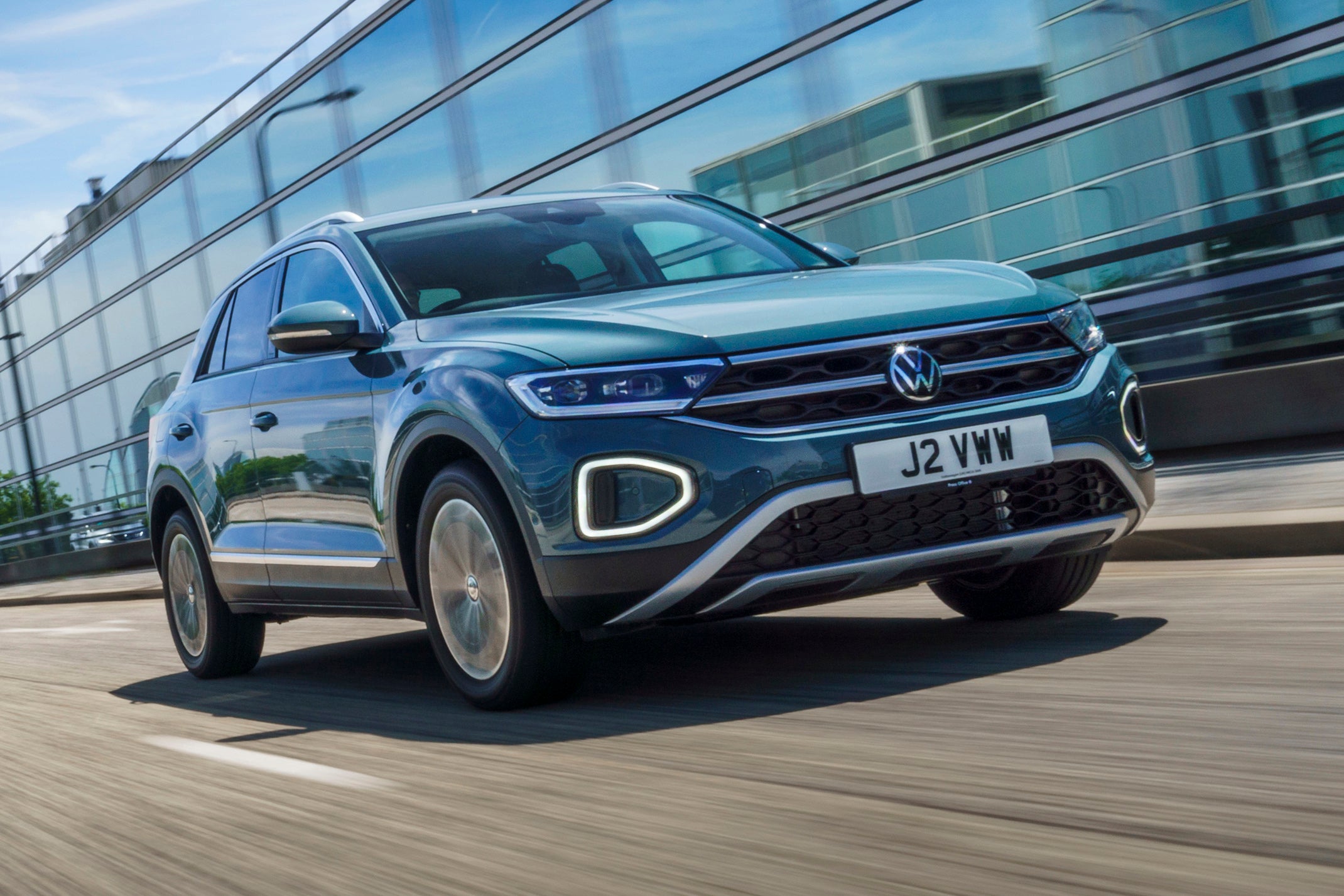Volkswagen T-Roc Review 2025: Price, specs & boot space
Written by Andrew Brady
Quick overview
Pros
- Facelift gets improved interior quality
- Comfortable and spacious small SUV with soft suspension
- Extensive engine line-up means there's a T-Roc for everyone
Cons
- Flimsy interior finishes on earlier models
- Not the most affordable car in its class
- A Ford Puma is more fun to drive
Verdict: Is the Volkswagen T-Roc a good car?
"The Volkswagen T-Roc remains one of the best small SUVs you can buy. The cabin has improved thanks to a 2022 facelift, while the exterior nip-and-tuck means it still looks fresh alongside newer rivals like the Ford Puma and Toyota Yaris Cross."
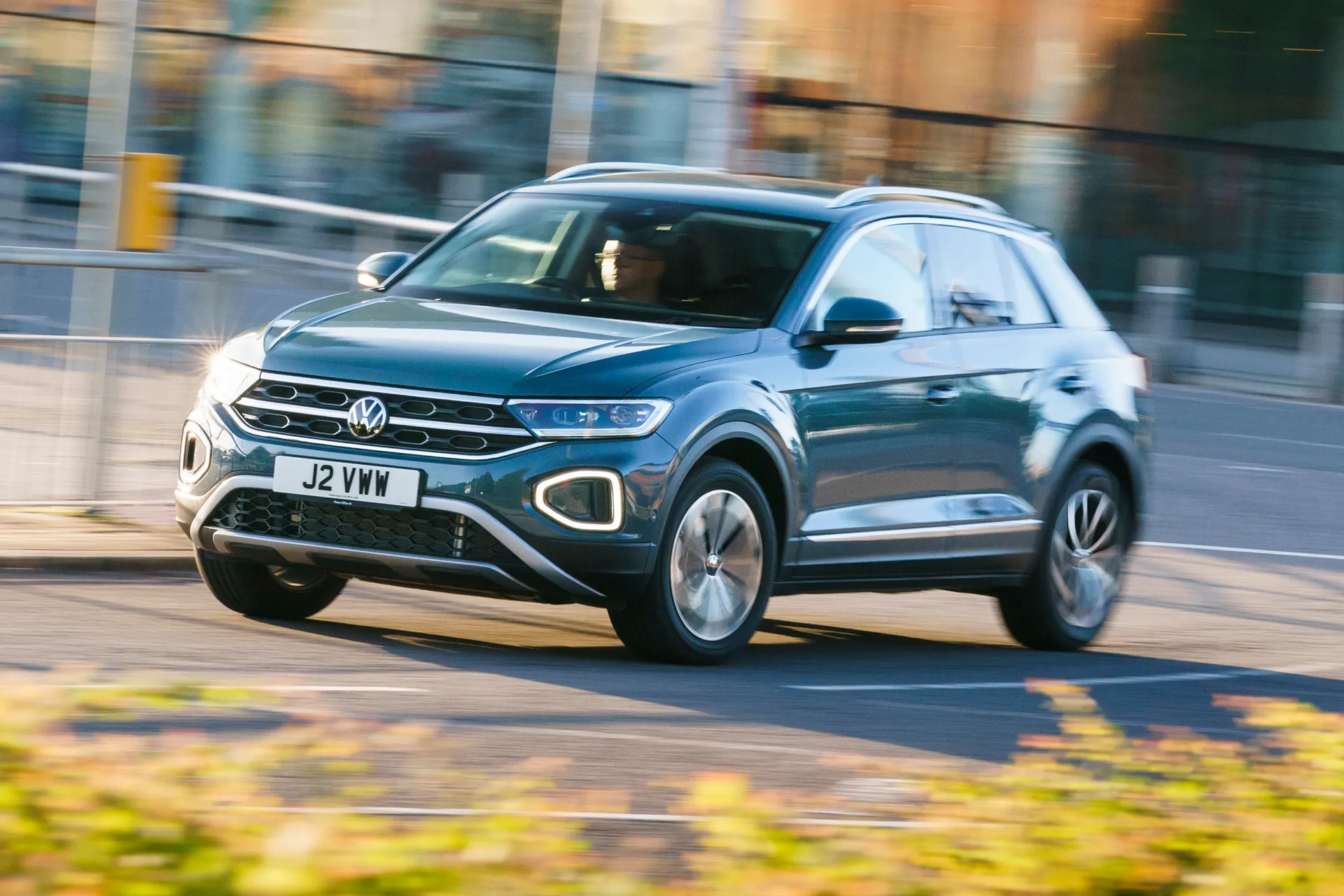
Think of the Volkswagen T-Roc as the Golf of the small SUV world. It's safe, comfortable and – while it's not quite as cheap to buy as rivals – it shouldn't cost you a lot to run in the long-term, as we'll find out in this 2025 VW T-Roc review. It has a lot more personality than the Golf, too, thanks in part to a range of bold interior and exterior colours.
The one area in which the Volkswagen T-Roc disappointed us when it first went on sale in 2018 was its interior finish. Early models had a slightly hard looking dashboard and a few flimsy finishes: something you might expect on a budget alternative like the Skoda Kamiq, but they looked out of place in a car designed to appeal to traditional Golf buyers.
A facelift in early 2022 steered the Volkswagen T-Roc back on form and ready to fight for your attention alongside rivals such as the Honda HR-V, Vauxhall Mokka, Renault Arkana and Mazda CX-30, not to mention premium stalwarts like the MINI Countryman, BMW X2 and Audi Q2.
It’s a more comfortable choice than many of its contemporaries. The Volkswagen T-Roc's ride quality is distinctly soft, especially with smaller wheels and the standard suspension. That also means it’ll lean more in corners than a Golf and isn’t as agile as a Ford Puma or SEAT Arona, but that’s a price many drivers would be happy to pay.
Aside from no hybrid or electric powertrains, the Volkswagen T-Roc’s engine line-up is pretty comprehensive. Petrol offerings range from a little 1.0 TSI (which is surprisingly good), through an impressively smooth and perky 1.5, to a powerful (and thirsty, and now-discontinued) 2.0 TSI with four-wheel drive. There’s the sporty Volkswagen T-Roc R, too, while most buyers will find the mid-level 1.5 TSI ticks all the boxes. Diesel units include a fairly dismal (and now discontinued) 1.6 TDI and a more likeable 2.0 TDI.
The interior is spacious, with a bigger boot than you'll find in a Volkswagen Golf. There's more room for rear-seat passengers than in a SEAT Arona, too, although the bigger Volkswagen Tiguan is a more versatile family SUV. Tech updates in 2022 added an 8.0-inch infotainment system perched high up on the dashboard in your line of sight, as well as a digital instrument cluster.
Prices for a new Volkswagen T-Roc start from a shade more than £28,000 new and you can easily splash more than £45,000 on the top-spec models. It holds its value well, though, while the latest improvements mean it might be worth stretching to a nearly-new or pre-registered model.
Looking for a used car for sale? We've got 100s of Volkswagen Approved Used Cars for Sale for you to choose from, including a wide range of VW T-Roc cars for sale. Looking for wind-in-your-hair motoring? You can even buy a Volkswagen T-Roc Cabriolet.
Is the Volkswagen T-Roc right for you?
If you want a stylish, small SUV with a versatile cabin, the Volkswagen T-Roc’s a great choice. It’s got more kerb appeal than the bigger Tiguan, yet families will find it more practical than the Golf hatchback.
With a suspension that focuses on comfort rather than sportiness, the Volkswagen T-Roc is an impressively comfortable choice. The strong engine line-up means there’s something for everyone. You can even get four-wheel-drive models, although these are fairly thirsty and to be avoided unless you really need to venture off-road.
What other cars are similar to the Volkswagen T-Roc?
There’s a whole range of small SUVs that contend with the T-Roc. These include other Volkswagen Group alternatives like the Skoda Kamiq, SEAT Arona and even the pricier Audi Q2. You could also consider the Mazda CX-30 – a left-field small SUV with a superb cabin – or the fashionable MINI Countryman. Then there's the Ford Puma: probably the small SUV our money would go on, although it's not quite as comfortable as the Volkswagen T-Roc.
Hybrid alternatives include the Honda HR-V, Toyota Yaris Cross (and bigger Toyota C-HR). You might also want to look at premium SUVs like the BMW X2 and Mercedes GLA, too.
Comfort and design: Volkswagen T-Roc interior
"The Volkswagen T-Roc's cabin was much improved with the 2022 facelift. Before that, it was very dependent on trim level: the more money the original owner chucked at it, the better it was. High-spec models are appealing, with some bold colour combinations available on the dashboard, door cards and around the centre console. Without them, early T-Roc models had a slightly drab cabin."
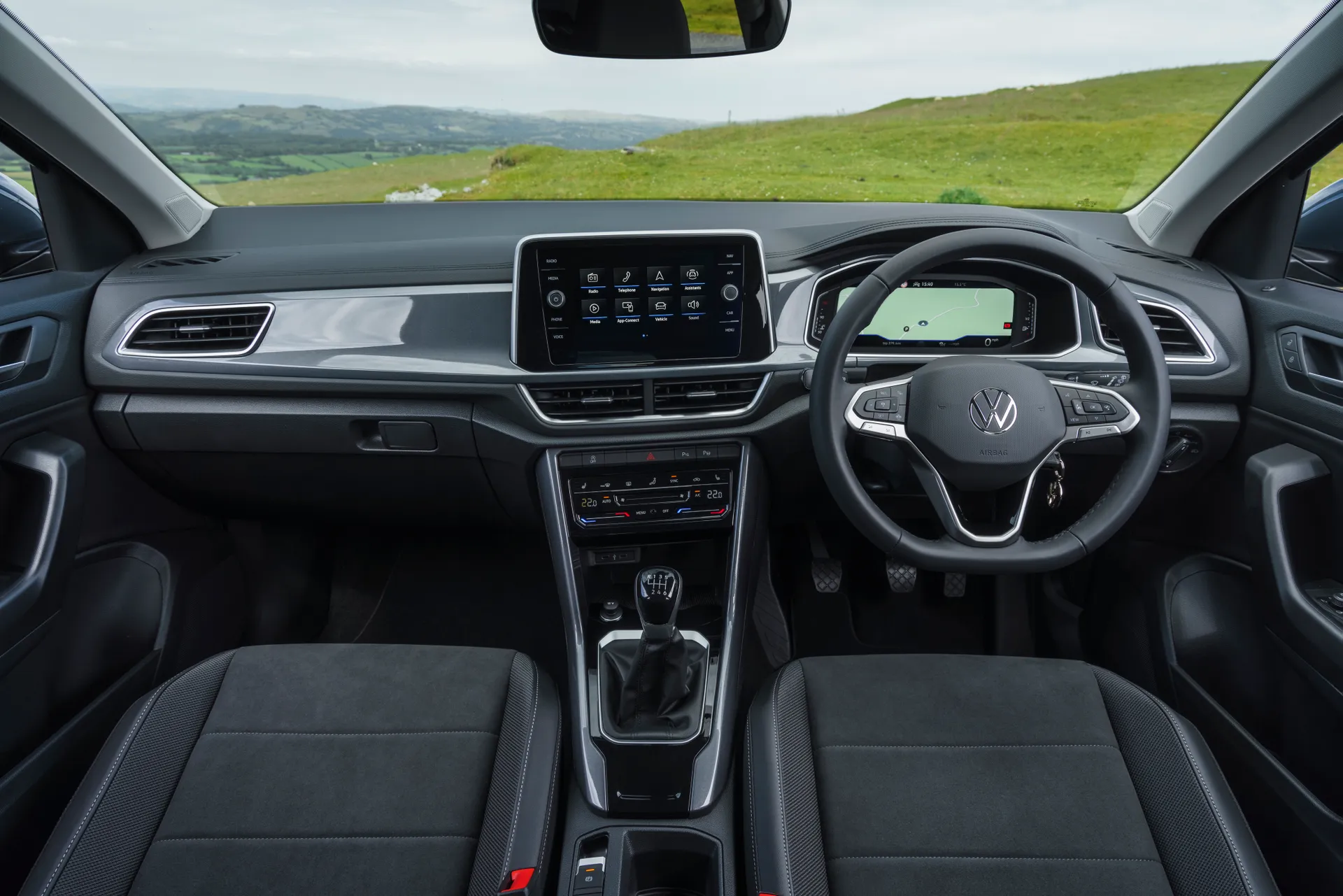
In terms of comfort, the T-Roc is a very amiable choice. Finding a driving position that’s to your satisfaction is easy thanks to seats that slide a long way backwards and forwards, along with a steering wheel with plenty of adjustment.
Disappointingly, many used Volkswagen T-Rocs won’t have adjustable lumbar support as it was only available as an option. Electric seat adjustment wasn’t even offered. Still, the seats are supportive, especially the sports seats of higher-spec models, and the high-up seating position ought to be good for your posture.
Pre-2022 Volkswagen T-Roc models were offered with an optional digital instrument cluster; something which became standard when the T-Roc was updated at the beginning of 2022. This is pretty cool and does a good job of giving the T-Roc a more upmarket vibe: it's worth hunting out a used example with one of these, if you can.
Quality and finish
The Volkswagen T-Roc was originally a bit of a mixed bag in terms of interior quality and finish, unfortunately. Don’t get us wrong, it's proving to wear very well and we’d be surprised to find one afflicted with rattles and creaks a few years down the line. However, it just doesn’t feel quite as plush as we’re accustomed to from Volkswagen, with some surprisingly non-premium plastic finishes and hard materials.
The original entry-level S model feels particularly cheap, lacking a leather-wrapped steering wheel or gear lever, and little to lift the cabin. These are areas that are addressed in the later Life base model. The Design model - on sale up to the start of 2022 - with its flashy dashboard inserts looks (and feels) a fair bit smarter.
No T-Roc has leather seats as standard, although they were an option on most models. We’d pay good money for a T-Roc with these on the used market as they feel significantly plusher than the standard cloth seats.
Things improved when the 2022 Volkswagen T-Roc went on sale, with its plusher dashboard design and fewer flimsy finishes. It's still not as posh as an Audi Q2, but it's a lot more satisfactory than it was before.
Infotainment: Touchscreen, USB, sat nav and stereo in the Volkswagen T-Roc
All T-Rocs come with an 8.0-inch infotainment display. Even the most affordable models don’t come with a small display surrounded by drab plastic where you’d ordinarily find a big navigation system.
The standard system used on the early Volkswagen T-Roc S covered all the basics but little more: it featured DAB radio, you could connect your phone via Bluetooth and there was even a CD player. The T-Roc SE added App Connect, with Apple CarPlay and Android Auto. That’s a good thing, as it can mirror apps from your phone onto the car’s infotainment system.
High-spec models came with navigation, pre-loaded with European mapping data. We’d rather use Google Maps via our phone, but in-built navigation’s a good idea if you’re precious about your data.
The infotainment offerings changed with the T-Roc's mid-life facelift in 2022. You still get an 8.0-inch touchscreen display, but it's now higher up on the dashboard as is the current trend. It's an easy and intuitive system to use, although we still prefer systems with a rotary controller like with in the Mazda CX-30.
Space and practicality: Volkswagen T-Roc boot space
The Volkswagen T-Roc might be smaller than conventional family SUVs like the SEAT Ateca and Nissan Qashqai, but it’s not far off in terms of practicality.
For a start, the Volkswagen T-Roc's boot capacity is capable of lugging up to 445 litres of stuff (sorry, we mean your prized possessions). That drops to 392 litres if you buy a four-wheel-drive T-Roc. That compares well to the likes of the SEAT Arona (400 litres), Mazda CX-30 (430 litres) and Kia XCeed (426 litres), although the Honda HR-V (470 litres) and Ford Puma (468 litres) pip it in this respect.
It’s a nice shape, if a boot can be such a thing: usefully square, without too many intrusions. A false boot floor reduces the amount of lip for lifting heavy items over, while there’s even space for a space-saver spare wheel. That’s a useful thing and not one that can be taken for granted in the age of the tyre repair kit.
The external dimensions of the Volkswagen T-Roc are 4236mm in length, a width of 1819mm and a height of 1559mm. That makes it larger in every dimension than the SEAT Arona, bringing it closer to Volkswagen Golf-sized models.
In terms of accommodating people, the T-Roc is a very spacious car. A pair of adults in the front won’t find themselves bashing elbows all the time thanks to a decently wide cabin. There’s a huge amount of headroom, too, while the door pockets are usefully large. The cup holders are big enough to handle a pair of takeaway coffees and there’s a handy cubby box underneath the front armrest. Most T-Roc models even come with a drawer under the driver’s seat.
There’s a surprising amount of room for rear passengers in the Volkswagen T-Roc, too. You'll fit a pair of adults almost as comfortably as you will in a Golf (albeit with slightly less legroom), and the T-Roc’s wide dimensions mean there’s more room for a middle passenger than usual. Having said that, you will sit perched slightly higher than other rear occupants, and it’s still going to be fairly cramped back there with three people in the rear seats.
There are ISOFIX child-seat mounting points fitted to the outer rear seats. These are easy to get at, and the T-Roc’s relatively high rear seat and wide-opening rear doors help, too.
Handling and ride quality: What is the Volkswagen T-Roc like to drive?
"You probably won’t find a more comfortable small SUV than the Volkswagen T-Roc, particularly if you buy a low-spec model with their standard small wheels. It does a commendable job of absorbing bumps in the road without passing them onto your passengers, yet feels pleasingly planted at speed."
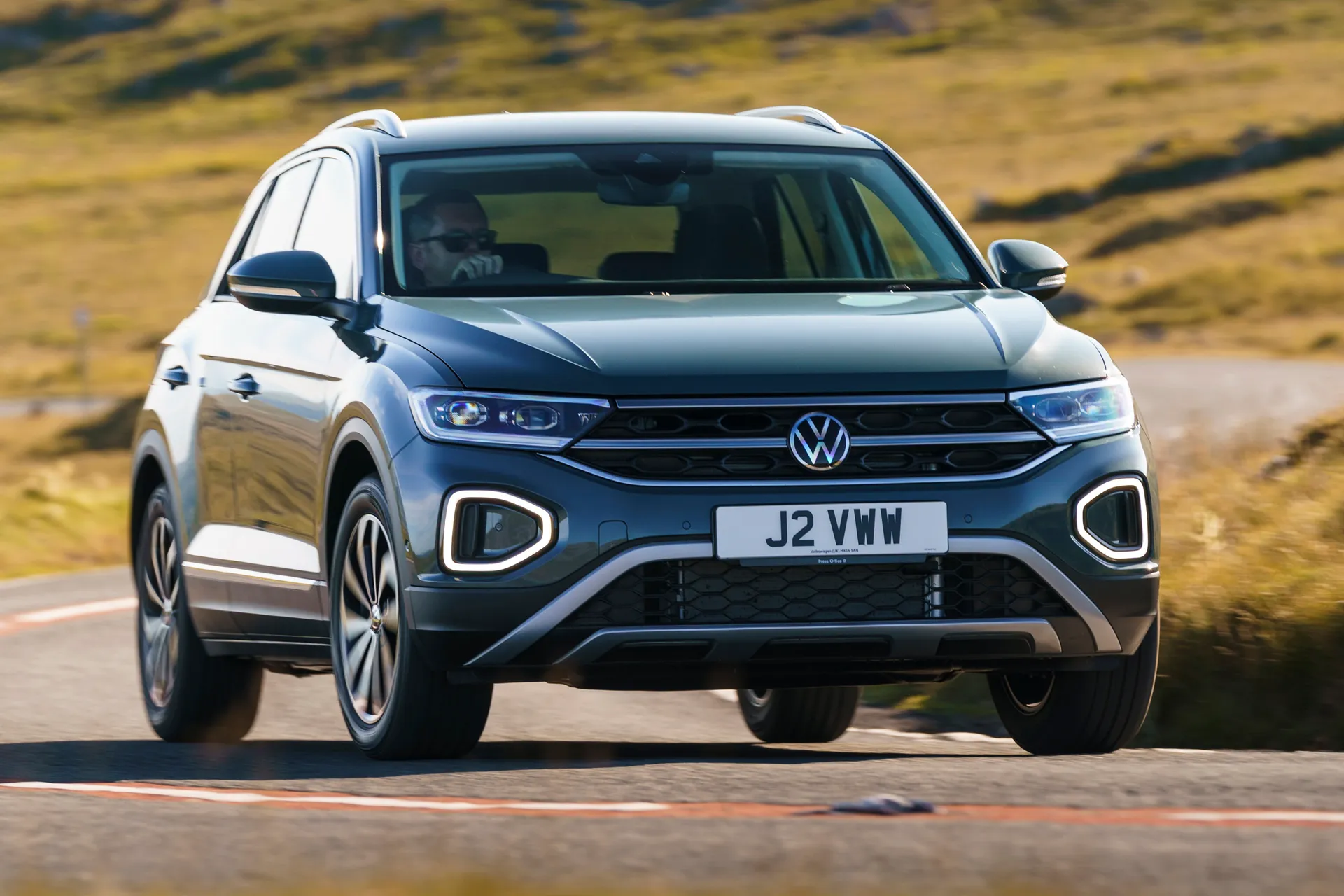
Higher-spec Volkswagen T-Roc models with bigger wheels feel a bit firmer, but they’re not overly harsh. You’ll have to be prepared to slow down a bit more for speed bumps if you buy a T-Roc R-Line with its lowered sports suspension (also offered as an option on lesser models), but even this is on the acceptable side of firmness.
Some T-Rocs have adaptive dampers (known as Dynamic Chassis Control, in Volkswagen speak, and part of the Sports Pack). These are an option when new, and give the driver the choice of three suspension settings: Sport, Comfort and Normal. It’s a nice feature to have, but one we wouldn’t pay a great deal extra for.
Whichever suspension the Volkswagen T-Roc of your desire has, it’ll put comfort over outright nimbleness. In plain English, no T-Roc is as fun to throw around as the Ford Puma, and even the very similar SEAT Arona feels a bit more agile.
Still, the T-Roc feels planted and safe, which is what most small SUVs buyers want. The steering’s light, which makes it easy to negotiate city streets, and you get a better view than you do in many small SUVs (although it’s not exactly a Range Rover-like commanding driving position).
All but the cheapest T-Rocs come with front- and rear parking sensors, which are very useful when parking, while some will feature a rear-view camera: that’s offered as an option when new. From 2022 on, all-round parking sensors became standard across the T-Roc range.
What engines and gearboxes are available in the Volkswagen T-Roc?
The best engine for most buyers is actually the most popular. It’s the 1.5 TSI petrol engine, which packs 150PS and is available with a six-speed manual or seven-speed DSG automatic gearbox. It's got more than enough grunt for overtaking, while also being efficient and refined. Unless you cover mega miles (in which case, get a diesel), it’s probably the perfect choice for you.
If you’re on a budget, you might notice the little 1.0 TSI coming up a lot in your search. Don’t be put off by its diminutive size: it’s a little turbocharged three-cylinder engine that provides surprisingly sprightly performance. Sure, it starts to run out of puff at motorway speeds, but it’s ace around town. It won't prove significantly more economical than the 1.5, however.
It's been dropped now, but there was also a 2.0 TSI unit that came with 4Motion four-wheel-drive. Unless you really, really want 190PS and four-wheel drive, it’s not really worth the drop in efficiency. Sure, it’s fun, but you’d be better looking for the properly hot 300PS T-Roc R if you want performance car thrills.
Despite their bad press, diesels still suit a lot of drivers. If you cover a lot of miles out of town, look for one of the T-Roc TDIs. The now-dropped 1.6 TDI (it left the line-up in mid-2022) was the entry-level diesel and, frankly, it feels it with sluggish performance that’ll have you pulling your hair out when you want to join a motorway.
The 2.0 TDI is much better. With 150PS, it requires a lot less effort to drive, while it was initially offered with four-wheel-drive.
In terms of choosing between manual or automatic gearboxes, it comes down to personal preference. Neither are bad choices, although we think the DSG automatic transmission suits the T-Roc well. It responds quickly, although no one buys a car like this because they want to hustle the gearbox...
Refinement and noise levels
Like the Golf hatch (and most Volkswagen models, for that matter), the Volkswagen T-Roc does a superb job of isolating you from the outside world. There’s not a great deal of noticeable wind noise (despite its bluff shape) while road noise is also well-hushed, particularly on smaller wheels with chunky tyres.
Some engines are a little more vocal than others, but neither are particularly thrashy. The 1.0 TSI petrol sounds a little coarse when you work it hard (something you’ll find yourself doing a lot if you want to get anywhere out of town), so the 1.5 TSI petrol’s a better option if you’re concerned about noise levels.
The diesels are typically a little rumbly, especially the 1.6 TDI. The 2.0 TDI diesel is better although, like the 1.5 TSI, this is partly because it requires less effort to get it moving.
Whichever engine you pick, you won’t really notice any significant vibration through any of the controls. It’s almost like Volkswagen invests a lot of money making sure that doesn’t happen...
Safety equipment: How safe is the Volkswagen T-Roc?
The Volkswagen T-Roc comes with a bunch of the latest clever safety systems designed to prevent you from being involved in a crash. Pleasingly, most of them are standard across the entire range.
All models come with Volkswagen’s Front Assist feature. This is a radar-controlled system that monitors the distance between your car and the vehicle in front, warning you if you get too close. If it detects an imminent collision, it’ll warn the driver, before applying the brakes automatically if you don’t react. It’s probably wise not to become too reliant on it, but it’s a handy feature…
There’s also Lane Assist, which’ll gently nudge the steering if you start to veer from your lane, while the electronic parking brake has an auto-hold function to keep the car still when you’re stopped in traffic. All versions also get adaptive cruise control as of the 2022 update.
If you are involved in a crash, there’s a plethora of airbags to keep you well-cushioned, while the We Connect Go system can provide your location to the emergency services.
When the Volkswagen T-Roc was crash tested in 2017, Euro NCAP gave it a maximum five-star rating. That includes an impressive 96% score for adult occupants, 87% for children, 79% for pedestrians and 71% for its safety assist features.
MPG and fuel costs: What does a Volkswagen T-Roc cost to run?
"You can still buy a diesel Volkswagen T-Roc capable of returning up to 60.7mpg in official WLTP tests. With high fuel prices, we can see the temptation, but most buyers will be better looking for a petrol T-Roc."
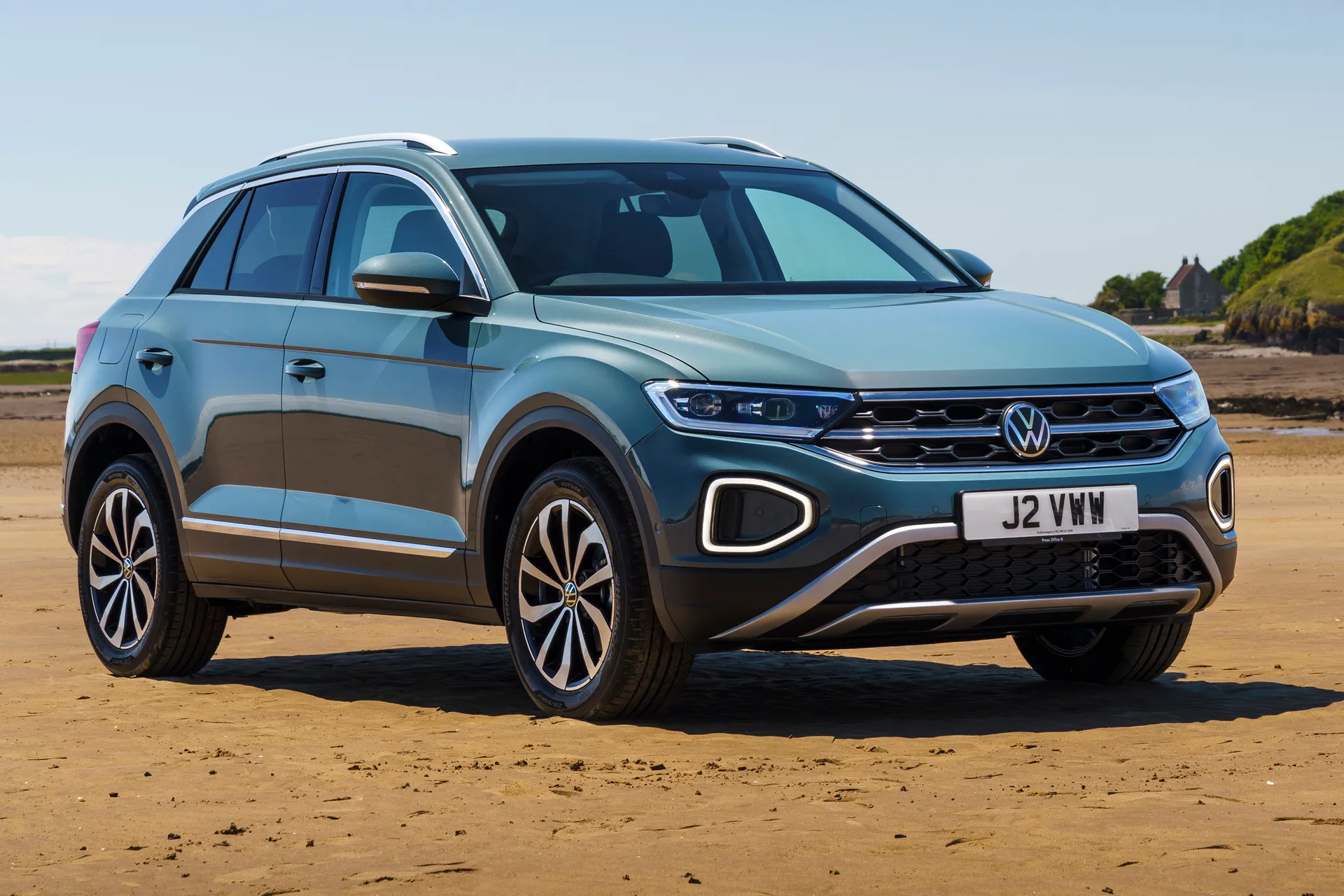
The little 1.0-litre TSI petrol can return up to 47.5mpg, while the 150PS 1.5 manages up to 47.3mpg with the manual gearbox (46.2mpg in DSG form).
Four-wheel-drive T-Rocs are the least efficient, with the 2.0-litre TSI 4Motion 190PS DSG only managing 38.4mpg in WLTP tests, and no doubt a chunk less in the real world.
Volkswagen T-Roc reliability and warranty
Volkswagen makes some very dependable cars, and the T-Roc performs well in the HonestJohn.co.uk Satisfaction Index. In the latest 2025 edition of the study, the T-Roc was VW's best-performing car, and was rated as the 20th most reliable model in the entire survey. VW as a brand, meanwhile, placed 15th out of 33 carmakers for reliability.
The only common issue we've heard of relates to the 1.5 TSI petrol engine, which can be a little hesitant when cold. This was fixed by an update in 2020, so make sure that's been done if you're buying used.
Volkswagen T-Roc insurance groups and costs
If you’re a young or inexperienced driver, look for a T-Roc 1.0 TSI or 1.6 TDI as these are the cheapest to insure. The former falls into group 11, while the latter’s insurance group 10. That’s very competitive against rivals. A Ford Puma, for example, starts from group 12.
The priciest models to insure are the four-wheel-drive 2.0-litre models. In R-Line trim, the 2.0 TSI 4Motion DSG falls into insurance group 28. That’s not outrageous, but it might be worth shopping around for quotes...
VED car tax: What is the annual road tax on a Volkswagen T-Roc?
Whichever model or engine you choose, the Volkswagen T-Roc will set you back a flat rate of £195 a year in tax (after the first year). Also bear in mind that the R and some top-spec versions of the R Line tip over the £40,000 threshold on price. That means these are liable for the luxury car VED surcharge, which means you'll have to pay an additional £425 per year on top of the flat rate until the car hits its sixth birthday. If you're considering a higher-spec T-Roc, Googling the reg before you buy can't hurt, as that'll tell you what you're looking at from a VED perspective.
Volkswagen T-Roc price
"A brand new Volkswagen T-Roc starts from around £29,000 at the bottom end of the range, and prices of the mainstream versions rise to around £39,000. The range-topping high-performance standalone R version will set you back around £45,000."
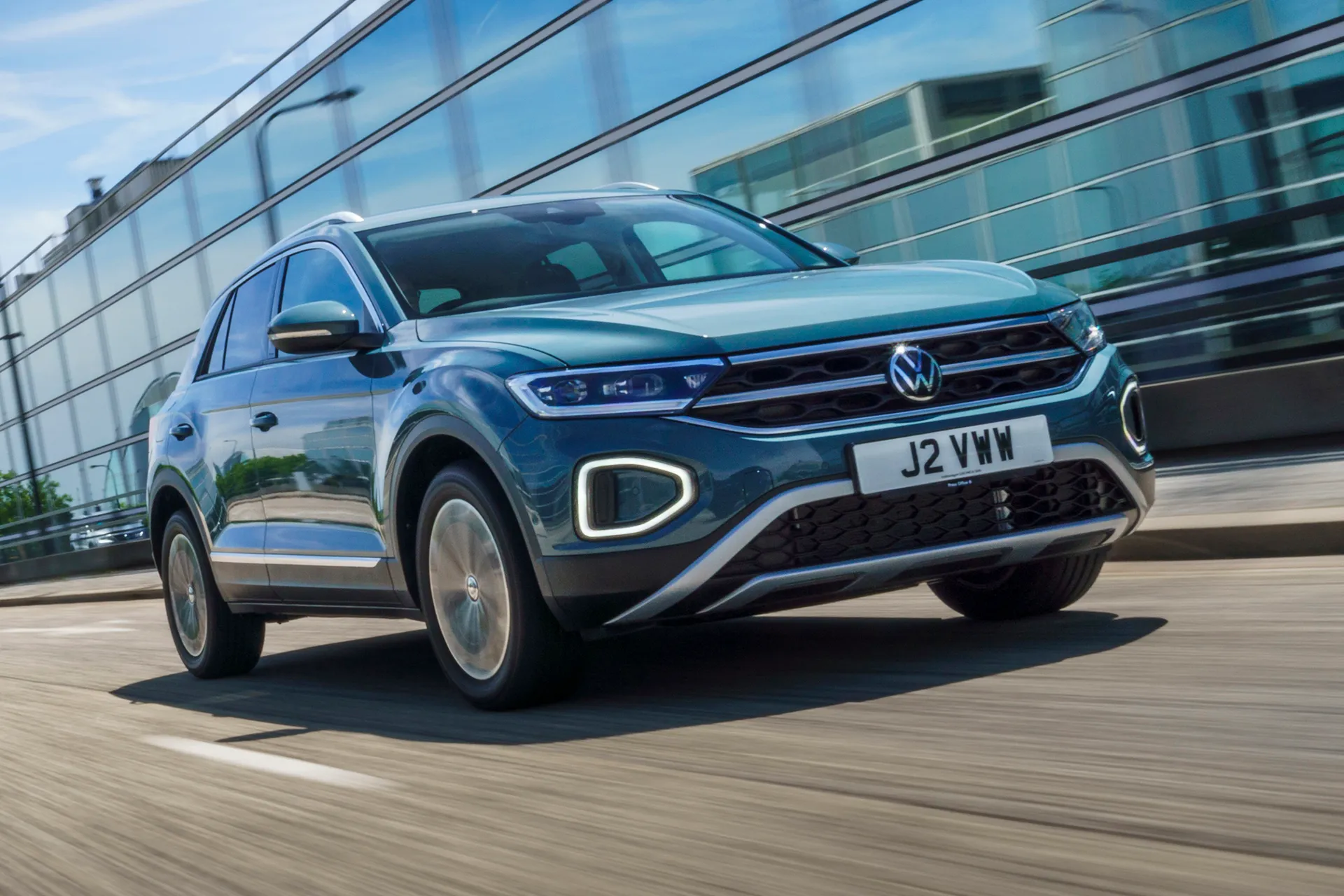
Used Volkswagen T-Roc values are strong, meaning you'll have to pay more for a secondhand example than many alternatives.
The earliest examples are now dropping to around £12,000, which will get you a 2018 Volkswagen T-Roc S or Design with the 1.0-litre petrol engine. If you can, though, we'd recommend searching out a car from after the 2022 facelift, which received significant improvements. These start at around £16,000 for a car with the 1.0-litre engine in entry-level Life trim, and will have covered somewhere in the region of 40,000 miles.
If you’d prefer an as-new car but don’t want to pay the retail price, look for an ex-demonstrator or pre-registered example. These are cars that have been ordered by dealers and are available to drive away now, usually for a healthy discount.
Trim levels and standard equipment
The regular Volkswagen T-Roc range now consists of the Life, Match, Style and R-Line. The hot R performance model is a standalone trim.
The entry-level Volkswagen T-Roc Life is pretty comprehensively kitted out with LED headlights, an 8.0-inch Digital Cockpit, wireless App Connect through its 8.0-inch Ready 2 Discover infotainment system, a suite of driver assistance systems including Lane Assist, Adaptive Cruise Control and Front Assist, and 16-inch ‘Chester’ alloy wheels, black roof rails and interior ambient lighting.
Move to the Match and you get 17-inch alloy wheels, rear parking camera, rear privacy glass, and keyless entry and ignition.
The Volkswagen T-Roc Style adds the larger Digital Cockpit Pro, a Discover Media navigation infotainment system, sports comfort seats finished in ArtVelours microfleece, privacy glass from the B-pillar backwards; and LED ‘Plus’ headlights with different light modes for poor weather. From the outside, a bespoke rear bumper and 17-inch ‘Johannesburg’ alloy wheels mark out the Style from the rest of the new T-Roc range.
The sportier range-topping Volkswagen T-Roc R-Line features bespoke body styling, 17-inch ‘Valencia’ alloy wheels, sports suspension, silver roof rails and an interior featuring sportier elements such as a black roof lining and R-Line badging, and gloss black design trim in the dashboard. Over the equipment of the Life specification, the T-Roc R-Line also gains features such as progressive steering, selectable driving modes, stainless steel pedals, and other interior enhancements contributing to a sporty ambience.
On earlier models, the most affordable car in the range was the Volkswagen T-Roc S. Specification highlights include 16-inch alloy wheels, two-zone climate control as well as an 8.0-inch media system with DAB radio and Bluetooth. It did the job but little more, essentially. Even an alarm was an optional extra...
The T-Roc SE built on this with 17-inch alloy wheels, electrically heated and foldable door mirrors, front- and rear parking sensors, adaptive cruise control and Apple CarPlay/Android Auto. There was also a host of desirable interior highlights, ranging from a handy little drawer under the driver’s seat to storage pockets behind the front seats, a front central armrest and a leather-trimmed steering wheel.
The Volkswagen T-Roc Black Edition looked the part with various black exterior highlights (including the 18-inch wheels, front grille, window surrounds and roof rails), piano black interior inserts and ambient lighting.
The T-Roc Design trim level built on the SE with 17-inch alloy wheels, a contrasting roof, tinted windows and sportier bumpers with silver styling. It could also be equipped with a variety of interior dashboard colours, while ambient lighting was standard. There was also a Driver Alert system, which would warn you to take a break if you appeared tired.
Moving up the range, the pricier Volkswagen T-Roc SEL featured 18-inch wheels, LED headlights and LED darkened rear clusters, front sports seats and an 8.0-inch navigation system with voice activation. T-Roc SEL models featured a 10.3-inch digital instrument cluster, too, while driver profile selection allows you to select between a variety of drive modes.
The T-Roc R-Line topped the range with its lowered sports suspension and 19-inch alloy wheels. There was various R-Line exterior trim highlights including a rear roof spoiler. Inside, you'd find a plethora of R-Line badging, including embossed on the front sports seats (which are also heated). There’s progressive steering and heated windscreen washer jets, too.
As for the very quick R, it has a unique body styling kit, 18-inch Jerez alloy wheels, LED Plus headlights, and twin chrome exhaust tips. It also has four-wheel drive as standard, plus silver roof rails. Inside, the R enjoys the benefits of the Digital Cockpit Pro, leather-clad sports steering wheel with paddle shifters, and Karoso R fabric upholstery with the side bolsters finished in ArtVelours microfleece trim.
In the summer of 2024 a T-Roc R Black Edition was added to the line-up. Based on the standard T-Roc R, it has black decorative trim and roof rails, black mirror housings and black 19-inch alloy wheels, while inside it boasts upgrades over the standard R model, with a rear-view camera, heated front seats and an electrically operated boot lid, as well as a tilting and sliding panoramic sunroof. There's a Beats sound system, too.
Ask the heycar experts: common questions
What is the Volkswagen T-Roc?
Where is the Volkswagen T-Roc manufactured?
Is the Volkswagen T-Roc a 4x4?
What does T-Roc stand for?
What is the boot size of the T-Roc?
Get our latest advice, news and offers
Keep me updated by email with the latest advice, news and offers from heycar.
By submitting you agree to our privacy policy
